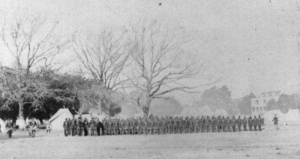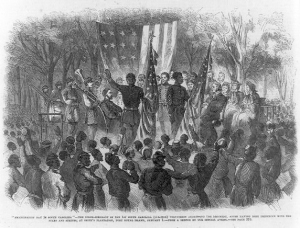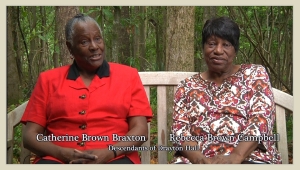Voted the Best Place to See by Condé Nast Traveler.

Please welcome our good friend Toni Carrier back to the blog! She was gracious enough to do an interview with us earlier in the year, and we discussed her ongoing research involving Drayton Hall and her amazing work at Lowcountry Africana. (Click here to read the interview.) Now she’s written a piece for our readers to enjoy about the first Emancipation celebration in South Carolina, which occurred in 1863. Incredibly enough, one of the participants of this joyous celebration was Samuel Ulin, the great-great-grandfather of Rebecca Brown Campbell and Catherine Brown Braxton, descendants of the Bowens-Johnson family formerly enslaved at Drayton Hall. Rebecca and Catherine are longtime supporters of Drayton Hall, and Catherine was just recently elected to our board. We love how Lowcountry Africana connects us to the past in such a tangible way. Thanks for blogging Toni!
The morning of January 1, 1863 was greeted with great excitement in the Union military encampment on the Old Fort Plantation of J.J. Smith near Beaufort, South Carolina, for on that day a great celebration was to take place.
Port Royal had been captured on the morning of November 7, 1861. In the days following the capture of Port Royal, some 5,000 African Americans enslaved in South Carolina, Georgia and Florida had escaped from bondage and volunteered to serve in the United States Colored Troops (USCT) to fight for the freedom of those still enslaved [1].
The first full regiment of United States Colored Troops in South Carolina had been mustered in in early November of 1862 as the 1st South Carolina Volunteer Infantry (later designated 33rd United States Colored Troops) [2]. Colonel Thomas Wentworth Higginson, an abolitionist from Massachusetts, had received command of the 1st South Carolina Volunteer Infantry regiment, arriving in Beaufort in late November of 1862. Upon his arrival in camp, he commenced a journal of his experiences, and it is from his journal that we learn of the grand celebration on New Year’s Day of 1863.

Above: Detail from “Dress parade of the 1st South Carolina [U.S.C.V.], Beaufort, S.C.” Library of Congress Digital Print LC-USZ62-62492 No Known Restrictions on Publication.
And so the day began with anticipation and excitement. Expecting a gathering of some 5,000 celebrants, Higginson had ordered ten cattle to be roasted. About 10:00 a.m. guests began arriving and soon every approach to the Smith plantation was thronged. The ceremony proceeded as planned, with the presentation of the regimental colors and reading of the Emancipation Proclamation. Then, as Higginson described, “followed an incident so simple, so touching, so utterly unexpected and startling, that I can scarcely believe it on recalling, though it gave a key-note to the whole day.”

“Emancipation Day in South Carolina” – the Color-Sergeant of the 1st South Carolina (Colored) addressing the regiment, after having been presented with the Stars and Stripes, at Smith’s plantation, Port Royal, January 1
Source: Library of Congress Digital Photo ID LC-USZ62-88808. No Known Restrictions on Publication.
The moment the speaker ceased and as Higginson took and waved the flag, from out of the assembled crowd came a lone male voice in song: “My Country ‘t is of Thee, Sweet Land of Liberty, of Thee I Sing.” This spontaneous celebration was soon joined in by others in the crowd. Higginson described the moment:
I never saw anything so electric. It made all other words cheap. It seemed the choked voice of a race at last unloosed. Nothing could be more wonderfully unconscious; art could not have dreamed of a tribute to the day of jubilee that should be so affecting; history will not believe it and when I came to speak of it after it was ended tears were everywhere.
One of the celebrants who witnessed this event was Samuel Ulin, the great-great-grandfather of Rebecca Brown Campbell and Catherine Brown Braxton, descendants of the Bowens-Johnson family formerly enslaved at Drayton Hall.

Above: Catherine Brown Braxton and Rebecca Campbell, Descendants of Drayton Hall and Great-Great Granddaughters of Samuel Ulin. Photo Courtesy of Jay Millard
Samuel Ulin had escaped bondage in Florida and made his way to Port Royal, where he enlisted in the United States Colored Troops (USCT) on November 11, 1862. Born in Duval County, Florida, Samuel was 39 when he enlisted in the USCT for a term of three years. Ulin was present at the grand celebration of January 1, 1863 and was one of the Union soldiers of African descent officially freed on that day [4]. Samuel Ulin fought and was wounded in battle on July 9, 1863, when United States Colored Troops in three Union gunships engaged Confederate forces at Willtown Bluff. Samuel was one of 250 troops in the 1st SC Volunteer Infantry who departed Port Royal in three Union gunships – the John Adams, an armed ferry boat steamer, the Enoch Dean, an armed transport and the Governor Milton, an armed tug, on an excursion up the Edisto River on the afternoon of 9 Jul 1863. Their mission was to burn a railroad bridge some 30 miles up the river.

Above: Civil War Pension Index for Samuel Ulin, 33rd United States Colored Troops. Source: Civil War and Later Pension Files, Department of Veterans Affairs, Record Group 15, National Archives, Washington, D.C. Widow’s Pension Application No. 5833301, Nancy Ulin; Service of Samuel Ulin (Pvt., Co. G, 33rd United States Colored Troops, Civil War). Previous Invalid Pension No. 674522; Original Invalid Pension No. 652845
After a difficult journey in heavy fog, they anchored about 4 a.m. near the Morris Plantation. The bridge was defended by a small force of Confederate troops who were forced to retreat, but in the battle Samuel Ulin was shot through the right hand and in the left side of his chest. He was admitted to the Beaufort field hospital where he remained for two months. He was never quite well again, and his disability ultimately resulted in paralysis and his death August 19, 1893. His wife Nora Singleton, Rebecca Campbell and Catherine Braxton’s great-great grandmother, predeceased him in August of 1891 [5].
We do not yet know whether Samuel Ulin married Catherine and Rebecca’s great-great grandmother Nora Singleton before or after his service in the Union army, but because he was among the first soldiers to enlist in the United States Colored Troops in South Carolina, a rich narrative of the events he witnessed survives in two books, now digitized and available on the Internet. The first is Thomas Wentworth Higginson’s diary Army Life In a Black Regiment, which chronicles his experiences while commanding the regiment Samuel Ulin served in (the 1st South Carolina Volunteer Infantry, later designated 33rd United States Colored Troops). The second is Reminiscences of My Life in Camp with the 33d United States Colored Troops Late 1st S.C. Volunteers by Susie King Taylor, an army nurse whose husband was a soldier in the 33rd USCT. You can read the full text of each of these books in the South Carolina Full Text Reading Room on the Lowcountry Africana website.
Left: Detail from Compiled Service Record of Samuel Ulin. Source: Compiled Military Service Records of Volunteer Union Soldiers Who Served with the United States Colored Troops: Infantry Organizations, 31st through 35th. Database Online at Fold3.com, https://www.fold3.com/title_692/31st35th_infantry/, accessed 13 Dec 2012. Original Data from NARA M1992. Compiled Military Service Records of Volunteer Union Soldiers Belonging to the 31st through 35th Infantry Units, Organized for Service With the United States Colored Troops (USCT).
FURTHER READING:
For more information on the history of the 33rd United States Colored Troops, please see Who Lived This History? The 33rd United States Colored Troops (USCT) on the Lowcountry Africana website.
For Thomas Wentworth Higginson and Susie King Taylor’s accounts of camp life among the 33rd USCT, please visit the South Carolina Full Text Reading Room on the Lowcountry Africana website.
REFERENCES CITED:
[1] Rose, Willie Lee. 1964 Rehearsal for Reconstruction: The Port Royal Experiment. Athens: University of Georgia Press, pp. 194-196.
[2] Rose 1964, pp. 194-196.
[3] Higginson, Thomas Wentworth. 1870 Army Life In a Black Regiment. Boston: Fields, Osgood and Company. Original from Oxford University, Digitized by Google Books 22 May 2007.
[4] Compiled Military Service Records of Volunteer Union Soldiers Who Served with the United States Colored Troops: Infantry Organizations, 31st through 35th. Database Online at Fold3.com, https://www.fold3.com/title_692/31st35th_infantry/, accessed 13 Dec 2012. Original Data from NARA M1992. Compiled Military Service Records of Volunteer Union Soldiers Belonging to the 31st through 35th Infantry Units, Organized for Service With the United States Colored Troops (USCT).
[5] Jones, Keith J. 2011 The Boys of Diamond Hill: The Lives and Civil War Letters of the Boyd Family of Abbeville, South Carolina. McFarland Publishers; Civil War and Later Pension Files, Department of Veterans Affairs, Record Group 15, National Archives, Washington, D.C. Widow’s Pension Application No. 5833301, Nancy Ulin; Service of Samuel Ulin (Pvt., Co. G, 33rd United States Colored Troops, Civil War). Previous Invalid Pension No. 674522; Original Invalid Pension No. 652845.